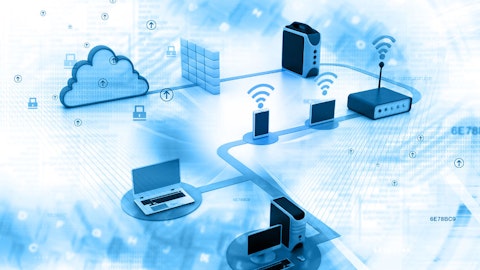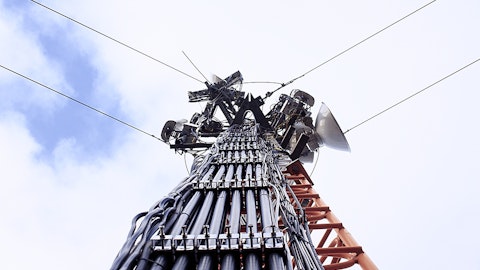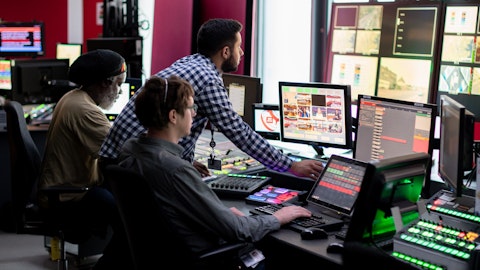Iridium Communications Inc. (NASDAQ:IRDM) Q3 2023 Earnings Call Transcript October 19, 2023
Iridium Communications Inc. misses on earnings expectations. Reported EPS is $-0.01 EPS, expectations were $0.03.
Operator: Good morning everyone. Welcome to the Iridium Communications’ Third Quarter 2023 Earnings Conference Call. All participants will be in a listen-only mode. [Operator Instructions]. Please also note that this event is being recorded. And at this I like to turn the floor over to Ken Levy, Vice President of Investor Relations. Sir, please go ahead.
Kenneth Levy: Thanks, Jamie. Good morning, and welcome to Iridium’s third quarter 2023 earnings call. Joining me on this morning’s call are CEO, Matt Desch; and our CFO, Tom Fitzpatrick. Today’s call will begin with a discussion of our third quarter results followed by Q&A. I trust you’ve had an opportunity to review this morning’s earnings release, which is available on the Investor Relations section of Iridium’s website Before I turn things over to Matt, I’d like to caution all participants that our call may contain forward-looking statements within the meaning of the Private Securities Litigation Reform Act of 1995. Forward-looking statements are statements that are not historical facts and include statements about our future expectations, plans, and prospects.
Such forward-looking statements are based upon our current beliefs and expectations and are subject to risks, which could cause actual results to differ from forward-looking statements. Such risks are more fully discussed in our filings with the Securities and Exchange Commission. Our remarks today should be considered in light of such risks. Any forward-looking statements represent our views only as of today and while we may elect to update forward-looking statements at some point in the future, we specifically disclaim any obligation to do so even if our views or expectations change. During the call, we’ll also be referring to non-GAAP financial measures, including operational EBITDA, pro forma free cash flow, free cash flow yield and free cash flow conversion.
These non-GAAP financial measures are not prepared in accordance with Generally Accepted Accounting Principles. Please refer to today’s earnings release and the Investor Relations section of our website for further explanation of these non-GAAP financial measures as well as a reconciliation to the most directly comparable GAAP measures. With that, let me turn things over to Matt.
Matthew Desch: Thanks, Ken. Good morning, everyone. I know that many of you joined us for our Investor Day less than a month ago, where we laid out our strategic growth objectives through 2030. We remain very excited about our business opportunities and bullish about our ability to grow revenues and generate meaningful cash — free cash flow for our business and investors. For those who may not have had the opportunity to listen to our Investor Day remarks, I would highlight our expectations that Iridium will generate about $1 billion in annual service revenue by 2030 and have the capacity to generate approximately $3 billion in shareholder returns during this seven-year period. During the program, we talked about our confidence in Iridium’s strong business position and ability to grow revenues and subscribers.
You certainly saw that in our results today. This outlook is based upon the ongoing strength of our core business lines and a number of growth vectors we will leverage through the end of the decade to support business expansion while maintaining our CapEx holiday. Despite market uncertainty about broader economic growth, Iridium’s financial stability continues to strengthen. Just before Investor Day, we completed the refinancing of our Term Loan B, which lowered our interest rate and extended the maturity of our credit facility by four years to September 2030. In light of all the competitive challenges in the satellite industry this year, Iridium continues to be a standout, not only for our ability to grow revenues and subscribers, but also for the health of our network and ability to grow organically without the need to buy a new platform or merge with competitors.
We do understand that investors would like more information about forecasting new direct-to-device revenues from our partnership with Qualcomm. Adoption of this service by manufacturers is slower than Qualcomm originally projected, but we continue to believe that Iridium will be a player over the coming years in smartphones, automobiles, and other consumer products. In the meantime, as you can see from today’s financial results, we are growing well in all our commercial business lines and continue to expect to do so. One area of business momentum has been in engineering revenue, particularly with our growing business with the Space Development Agency and the U.S. government. I’m sure you also saw news last month of Iridium’s involvement in the Space Force’s Proliferated LEO program.
This program supports DoD’s rapid response efforts and positions Iridium’s broadband services to be a core capability for the war fighter, even as new government-funded satellites deploy, for which Iridium will provide the ground operations support as well. I should also point out that we made another quarterly dividend payment on September 29th as we continue to return significant capital to shareholders. The Board’s confidence in our business prospects and commitment to capital returns is visible in their expansion of our Share Repurchase program, where they added a $400 million authorization earlier this summer and extended the program through 2025. Given that you’ve heard a lot from me and my team with the Investor Day a few weeks ago, I’ll keep my prepared remarks short today to allow more focus on your questions.
We take great pride in the way our business is performing, adding new partners and their new applications that drive growth and support our free cash flow. Like our past, our future will be based on continued strong execution and capitalizing on what we do best. So let me turn the call over to Tom now for a review of our financials. Tom?

A technician inspecting a satellite dish, highlighting the Mobile Voice and Data Services scope.
Thomas Fitzpatrick: Thanks, Matt, and good morning everyone. I’ll get started by summarizing our key financial metrics for the quarter and providing some color on the trends we’re seeing in our business lines. Then I’ll recap the 2023 guidance we updated this morning and close with a review of our liquidity position and capital structure. Iridium continued to execute well in the third quarter, generating total revenue of $197.6 million, up 7% from the prior year’s quarter. The improvement reflects ongoing growth in our commercial business lines and strengthened engineering and support revenues. Operational EBITDA hit a record $121.3 million in the third quarter. This was up 12% from the prior year’s quarter, driven by strength across all commercial business lines and engineering and support revenue.
On the commercial side of our business, service revenue was up 12% this quarter to $125.5 million. Growth was broad-based and reflected continued momentum. Commercial voice and data revenue grew $5.9 million, or 12% in the third quarter to $56.2 million. The increase was largely driven by the price changes we implemented earlier this year. To date, we’ve been pleased with how the new pricing has been received and expect that voice ARPU this year will remain in the mid-40s. In commercial IoT, we continue to benefit from demand for personal satellite communications. Revenue rose 14% from the prior year quarter to $38.5 million, with a shifting mix of subscribers resulting in IoT ARPU of $7.90 during the quarter. As I’ve discussed before, we like this growing business and the service revenue it generates relative to the network resources it consumes.
Commercial IoT subs grew 18% from last year’s third quarter, fueled by 89,000 net new additions. This was one of the biggest increases in our history. IoT data subscribers now represent 80% of billable commercial subscribers, up from 77% in the year-ago period. We estimate that consumer-oriented plans account for about 900,000 of our 1.7 million commercial IoT users. Commercial broadband revenue grew 16% from the year-ago period to $15.8 million. Similar to last quarter, we continue to benefit from Iridium Certus being adopted as the de facto standard companion to VSAT services in maritime, though we are seeing lower usage on certain vessels where Iridium Certus had been used as a primary. Hosting another data service revenue was $15 million this quarter, in line with last year’s comparable quarter and consistent with our hosting contracts.
Government service revenue was also steady in the third quarter at $26.5 million, reflecting the terms of our EMSS Contract with the U.S. government. Subscriber equipment revenue was $20.4 million in the third quarter, down by 27% from the comparable quarter last year. Based on trends and input from our channel partners, we had been expecting equipment sales for the full year to be in line with 2022. But with supply chain issues now resolved and partners not fighting for inventory, we have updated our outlook. We now expect equipment sales to be down in the fourth quarter and down for the full year. 2022 was a record year for equipment sales at $135 million, representing 150% of the prior three-year average. Our updated estimate for equipment sales is fully reflected in our latest estimate for 2023 OEBITDA.
While down from 2022, we expect 2023 equipment sales to remain above normalized historical levels and now expect this year to be the second highest on record. Going forward, we expect equipment sales to moderate to be more in line with historical averages. This is consistent with our comments at our recent Investor Day. Engineering and support revenue was $25.2 million in the third quarter as compared to $17.1 million in the prior year period. The increase reflects ongoing work for the U.S. government related to the Space Development Agency contract that we won last year. We continue to expect engineering revenue will be up significantly this year, but will fluctuate from quarter to quarter based upon execution and milestone achievements. Based upon our results through the third quarter and trends we’re seeing into October, we’re updating our full year guidance for service revenue growth to approximately 10% in 2023 and operational EBIDTA to between $460 million and $465 million.
You’ll note that SG&A was up 4% this quarter versus 48% in the first quarter. This was consistent with our expectation for moderation in year-over-year growth rates throughout the year, and we continue to expect SG&A to be up 20% for the full year. Moving to our capital position as of September 30, 2023, Iridium had a cash and cash equivalents balance of $67.9 million. Iridium’s growing cash flow has been a source of liquidity and continues to support our board’s confidence in quarterly dividend payments and an active share repurchase program. With their incremental authorization in July, our board now has authorized a total of $1 billion in buybacks since the program started in early 2021. Iridium paid a third quarter dividend of $0.13 per common share on September 29, and expects this program will return approximately $65 million of cash to common holders in 2023.
In the third quarter, we also purchased approximately 1.4 million shares of common stock at an average price of about $51.71 for about $75 million. We had approximately $385.7 million of capacity outstanding on our share repurchase program at the end of the quarter and will continue to execute on these buybacks. Iridium’s net leverage was 3.1 times OEBITDA at the end of the third quarter. This was down from 3.4 times a year earlier, even when factoring in our share repurchase and dividend activity. Our current expectation is for net leverage to be about three times OEBITDA at the end of 2023, inclusive of quarterly dividends and expected share buybacks. As we said on our investor day, we expect net leverage to decline to below two times OEBITDA as we exit 2030.
Capital expenditures in the third quarter were $12 million. We expect annual capital expenditures to average between $50 million and $60 million through 2030. Excluding launch-related costs, 2023’s capital expenditures should fall in line with this long-term forecast. Turning to our pro forma free cash flow, if we use the midpoint of our updated 2023 OEBITDA guidance and back off $76 million in net interest, approximately $75 million in CapEx for this year, and $16 million in working capital, which considers the increase in inventory we announced this year and a declining balance over the next few years, as well as the appropriate hosted payload adjustment, we’re projecting pro forma free cash flow of almost $300 million. These metrics represent a conversion rate to EBITDA, a free cash flow of 64% in 2023, and a yield of more than 5%.
A more detailed description of these cash flow metrics, along with the reconciliation of GAAP measures, is available in a supplemental presentation under events on our investor relations website. In closing, we remain very excited about Iridium’s ongoing strength and its many partnerships and prospects for growth. Demand for our LBAN services and equipment remains strong, and our business continues to perform well. We are incredibly excited about our future and are in a good position to continue to return capital to our shareholders as we fund new projects and make strategic investments. With that, I’ll turn things back to the operator for the Q&A.
See also 11 Best Technology Dividend Stocks To Buy and 10 Best Stocks That Pay Monthly Dividends.
Q&A Session
Follow Iridium Communications Inc. (NASDAQ:IRDM)
Follow Iridium Communications Inc. (NASDAQ:IRDM)
Operator: Our first question today comes from Ric Prentiss from Raymond James. Please go ahead with your question.
Ric Prentiss: Great. Thanks. Good morning, everybody.
Matthew Desch: Good morning, Rick.
Ric Prentiss: Hey. A couple questions. Matt, I know you said obviously we all are very interested in directed device info, and you mentioned maybe it’s been slower than Qualcomm predicted, but can you help us understand — I think you said previously that you expect $5 million to $10 million of directed device to come in this year. Can you update us as far as how much has come in so far in the quarter and year-to-date this year?
Matthew Desch: Tom, you want to take this? No, we’re just assembling that.
Thomas Fitzpatrick: Yes, it’s $5 to $10 in the full year. I don’t have the quarter information, Ric. We’ll have to double back with you on that.
Ric Prentiss: Okay, that’s fine.
Thomas Fitzpatrick: We continue to expect $5 to $10 in its development revenues. Right.
Ric Prentiss: Right. And as we think of moving towards royalties coming to you from the chip side, what’s the timing of your ability to recognize that revenue? Is it when the chip goes into the phone? Is it when the phone ships to the OEM? Is it when the customer buys the phone and then enables it? Just try to understand the logistical timing as we try and model this in the dark.
Thomas Fitzpatrick: So, the development revenues are what is the $5 to $10, and that is milestone-related for development work that we’ve done, okay. So, that’s that tranche. Then we get paid per the chip when Qualcomm orders a chip. That’s royalty revenue. And then, finally, when we entitle, when we entitle a device on our network, that’s the other element of revenue. And then when it’s used, there’s usage revenue.
Ric Prentiss: Okay. Is the entitlement going to be part of the E&S revenue, or is that rolling to services?
Thomas Fitzpatrick: That’s services. Think of that as access, Ric.
Ric Prentiss: Right. Monthly access type thing, and then when you use it, you get charged for usage. Okay. Yes. That helps. And then your cash balance came down a little bit this quarter. You did the, obviously, the debt refi in there. How much money should we think you want to keep on the balance sheet to kind of run the business as we look at what your free cash flow production would be and your ability to kind of hit the stock buyback?
Thomas Fitzpatrick: So, we were $67 million at the end of this quarter. We’re quite comfortable there. We took the cash balance down from year end by $100 million. $75 million of it was share buybacks.
Ric Prentiss: Okay. And then the last one for me is the competition in the legacy voice and data business in the past, and I think at the investor day, you also kind of mentioned, it seems like you’ve got still some good runway there competitively versus the competition’s ability to get handsets and provide service. How are you feeling on that legacy voice and data business as far as able to grow revenues? Obviously, it’s going to be a tough comp next year because you raised prices this year. It sounds like you’re not looking to raise prices, though.
Matthew Desch: Yes. I think it continues to be. We’re very well positioned there. The business continues to perform really well, better than we certainly expected with a price increase this year, which certainly demonstrates the strength of our offering over anyone else’s. And given that we’ve added new offerings in there, like with the Go products and Push to Talk and that sort of thing, those are all growth vectors for us as well. So you’re right. It’ll be a tough comp next year in terms of year-over-year growth, but I think you’re going to see continued absolute growth out in the future.



